Abstract
BACKGROUND: The prevalence of asthma is rising and there are recent reports of increasing asthma rates among top level skiers and runners in the Nordic countries. METHODS: The lifetime occurrence of pulmonary diseases (asthma, chronic bronchitis, emphysema) and current bronchitis symptoms was compared in former elite male athletes (n = 1282) who represented Finland between 1920 and 1965 at least once in international competitions and controls (n = 777) who, at the age of 20, were classified as healthy and who responded to a questionnaire in 1985. The presence of disease and symptoms was identified from the questionnaire and, in the case of asthma, also from a nationwide reimbursable medication register. The death certificates of the subjects of our original cohort who died between 1936 and 1985 were also investigated to determine the cause of death. RESULTS: The occurrence of the pulmonary diseases was associated with age, smoking habits, occupational group, and a history of exposure to chemicals. After adjusting for these variables, athletes who participated in mixed sports (odds ratio (OR) 0.46, 95% confidence interval (CI) 0.23 to 0.92) and power sports (OR 0.43, 95% CI 0.21 to 0.87) had lower odds ratios for emphysema, and endurance sports athletes had a lower odds ratio for the presence of at least one pulmonary disease (OR 0.53, 95% CI 0.28 to 0.98) when compared with controls. Athletes also tended to have fewer reimbursable medications for asthma and fewer current symptoms for chronic bronchitis. Between 1936 and 1985 two controls but none of the athletes died of asthma. CONCLUSIONS: The lifetime occurrence of asthma or other pulmonary diseases is not increased in former elite athletes, and exercise alone, even in a cold environment, did not appear to increase the prevalence of asthma, at least up to the mid 1980s.
Full text
PDF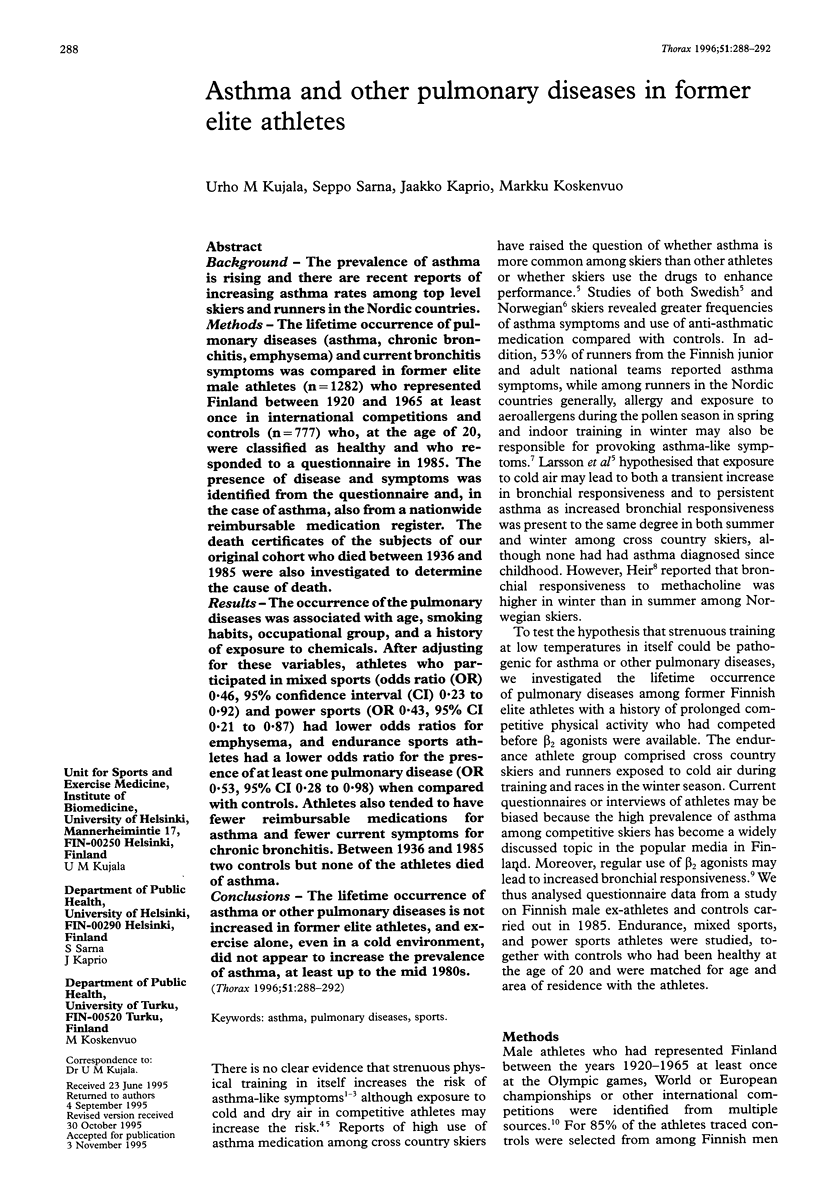
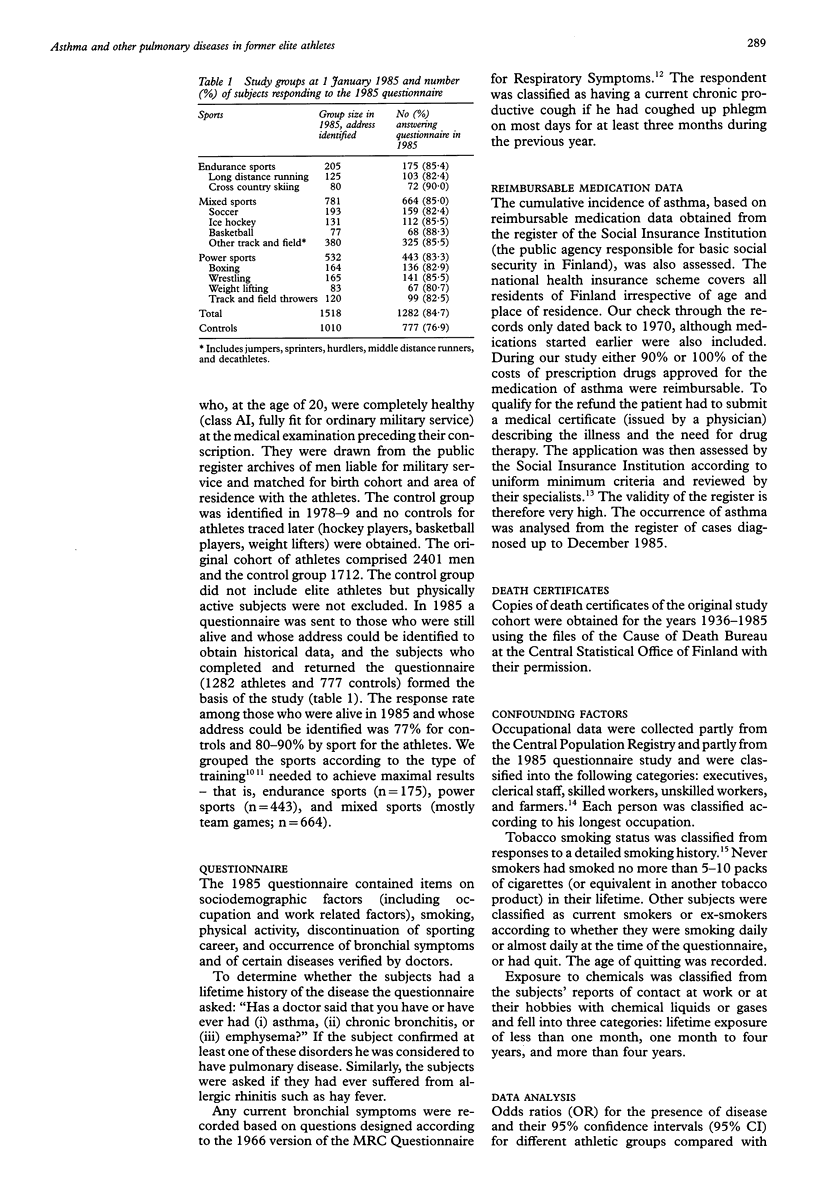
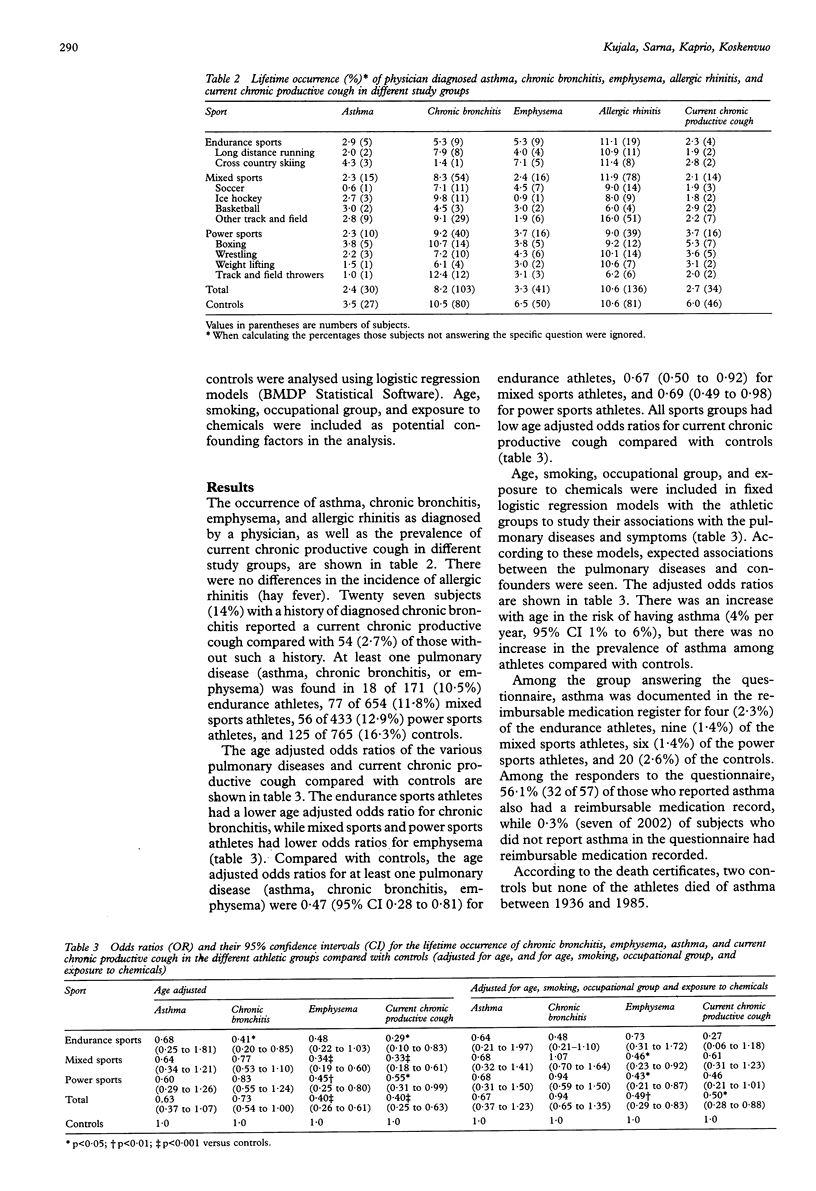
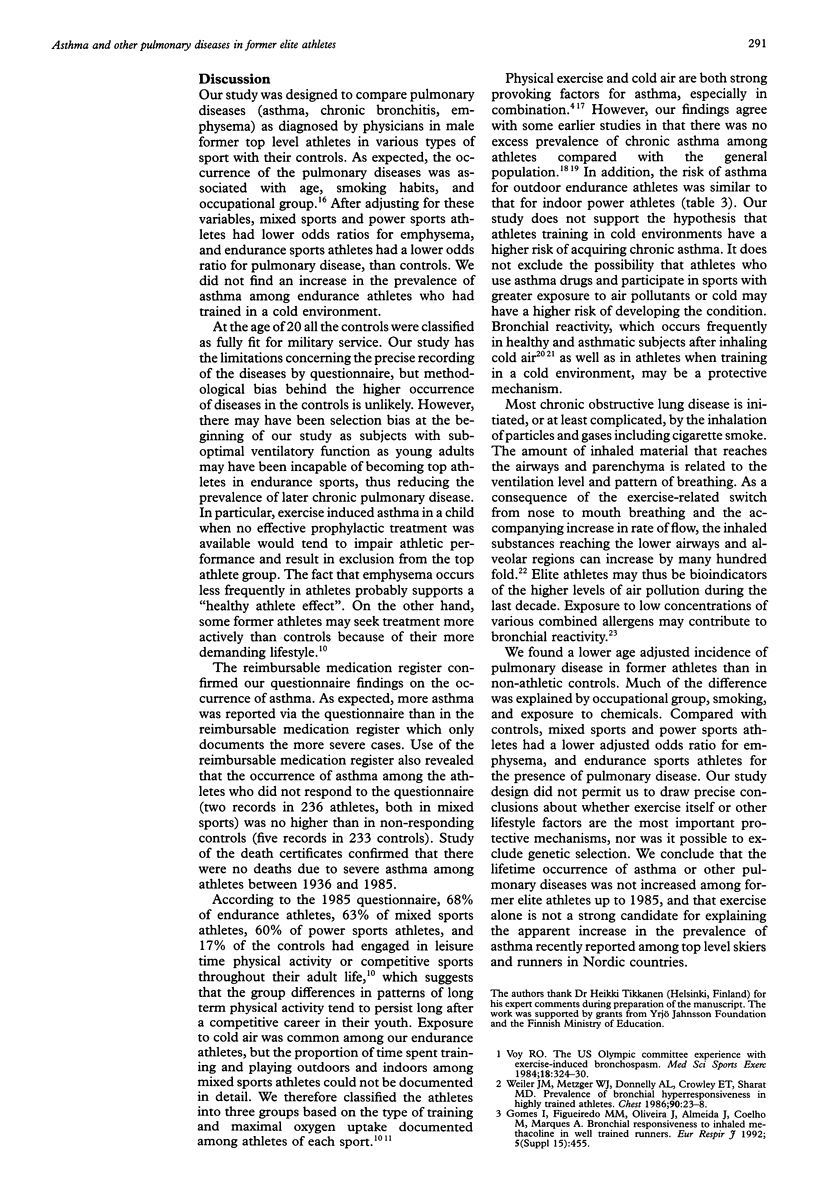
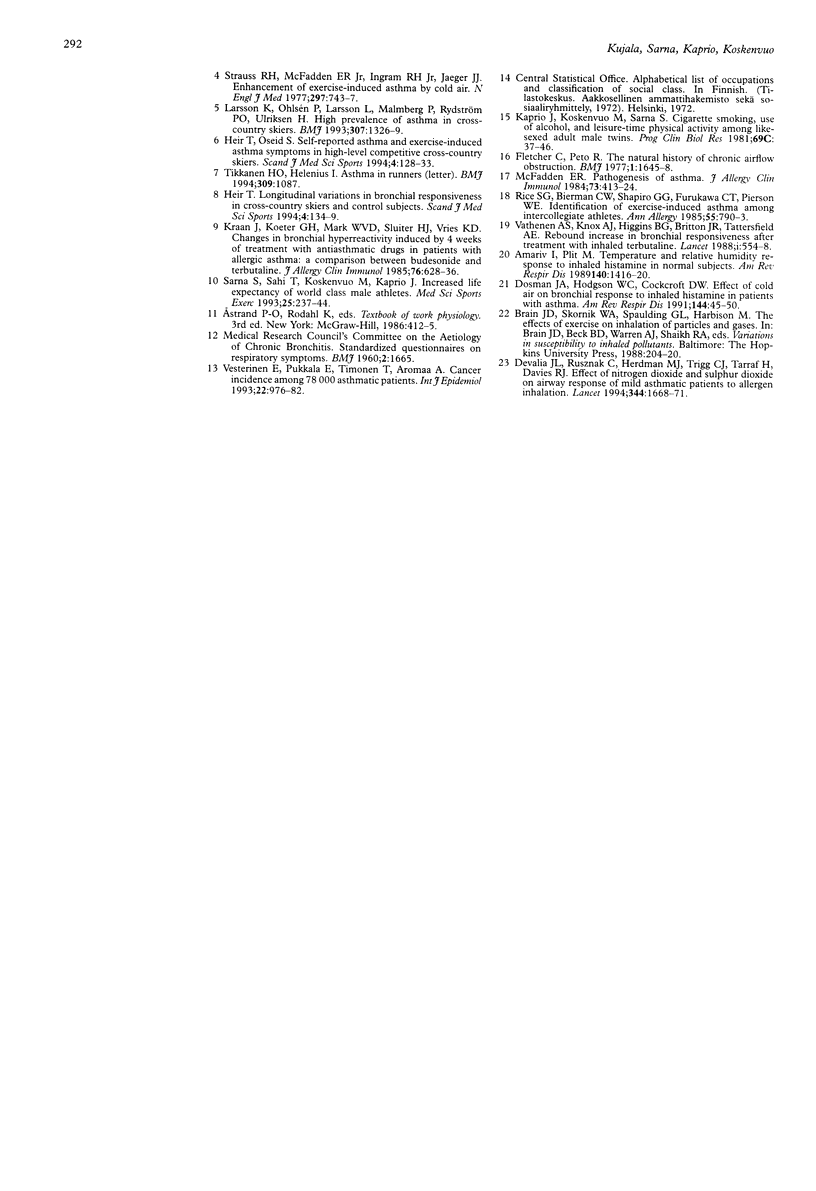
Selected References
These references are in PubMed. This may not be the complete list of references from this article.
- Devalia J. L., Rusznak C., Herdman M. J., Trigg C. J., Tarraf H., Davies R. J. Effect of nitrogen dioxide and sulphur dioxide on airway response of mild asthmatic patients to allergen inhalation. Lancet. 1994 Dec 17;344(8938):1668–1671. doi: 10.1016/s0140-6736(94)90458-8. [DOI] [PubMed] [Google Scholar]
- Fletcher C., Peto R. The natural history of chronic airflow obstruction. Br Med J. 1977 Jun 25;1(6077):1645–1648. doi: 10.1136/bmj.1.6077.1645. [DOI] [PMC free article] [PubMed] [Google Scholar]
- Kaprio J., Koskenvuo M., Sarna S. Cigarette smoking, use of alcohol, and leisure-time physical activity among same-sexed adult male twins. Prog Clin Biol Res. 1981;69(Pt 100):37–46. [PubMed] [Google Scholar]
- Kraan J., Koëter G. H., vd Mark T. W., Sluiter H. J., de Vries K. Changes in bronchial hyperreactivity induced by 4 weeks of treatment with antiasthmatic drugs in patients with allergic asthma: a comparison between budesonide and terbutaline. J Allergy Clin Immunol. 1985 Oct;76(4):628–636. doi: 10.1016/0091-6749(85)90786-9. [DOI] [PubMed] [Google Scholar]
- Larsson K., Ohlsén P., Larsson L., Malmberg P., Rydström P. O., Ulriksen H. High prevalence of asthma in cross country skiers. BMJ. 1993 Nov 20;307(6915):1326–1329. doi: 10.1136/bmj.307.6915.1326. [DOI] [PMC free article] [PubMed] [Google Scholar]
- McFadden E. R., Jr Pathogenesis of asthma. J Allergy Clin Immunol. 1984 Apr;73(4):413–428. doi: 10.1016/0091-6749(84)90347-6. [DOI] [PubMed] [Google Scholar]
- Rice S. G., Bierman C. W., Shapiro G. G., Furukawa C. T., Pierson W. E. Identification of exercise-induced asthma among intercollegiate athletes. Ann Allergy. 1985 Dec;55(6):790–793. [PubMed] [Google Scholar]
- Sarna S., Sahi T., Koskenvuo M., Kaprio J. Increased life expectancy of world class male athletes. Med Sci Sports Exerc. 1993 Feb;25(2):237–244. [PubMed] [Google Scholar]
- Strauss R. H., McFadden E. R., Jr, Ingram R. H., Jr, Jaeger J. J. Enhancement of exercise-induced asthma by cold air. N Engl J Med. 1977 Oct 6;297(14):743–747. doi: 10.1056/NEJM197710062971402. [DOI] [PubMed] [Google Scholar]
- Tikkanen H., Helenius I. Asthma in runners. BMJ. 1994 Oct 22;309(6961):1087–1087. doi: 10.1136/bmj.309.6961.1087. [DOI] [PMC free article] [PubMed] [Google Scholar]
- Vathenen A. S., Knox A. J., Higgins B. G., Britton J. R., Tattersfield A. E. Rebound increase in bronchial responsiveness after treatment with inhaled terbutaline. Lancet. 1988 Mar 12;1(8585):554–558. doi: 10.1016/s0140-6736(88)91352-9. [DOI] [PubMed] [Google Scholar]
- Vesterinen E., Pukkala E., Timonen T., Aromaa A. Cancer incidence among 78,000 asthmatic patients. Int J Epidemiol. 1993 Dec;22(6):976–982. doi: 10.1093/ije/22.6.976. [DOI] [PubMed] [Google Scholar]
- Weiler J. M., Metzger W. J., Donnelly A. L., Crowley E. T., Sharath M. D. Prevalence of bronchial hyperresponsiveness in highly trained athletes. Chest. 1986 Jul;90(1):23–28. doi: 10.1378/chest.90.1.23. [DOI] [PubMed] [Google Scholar]


